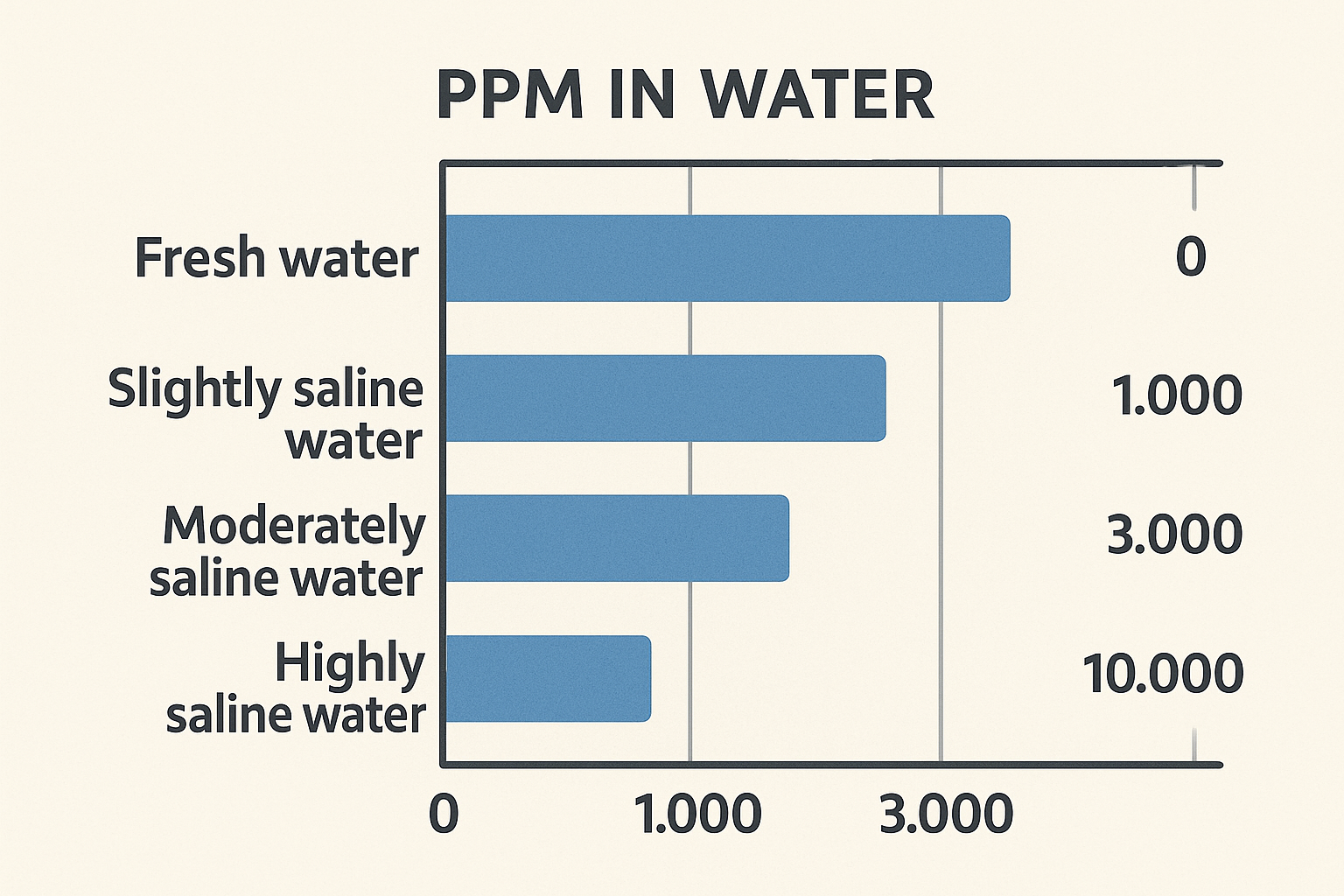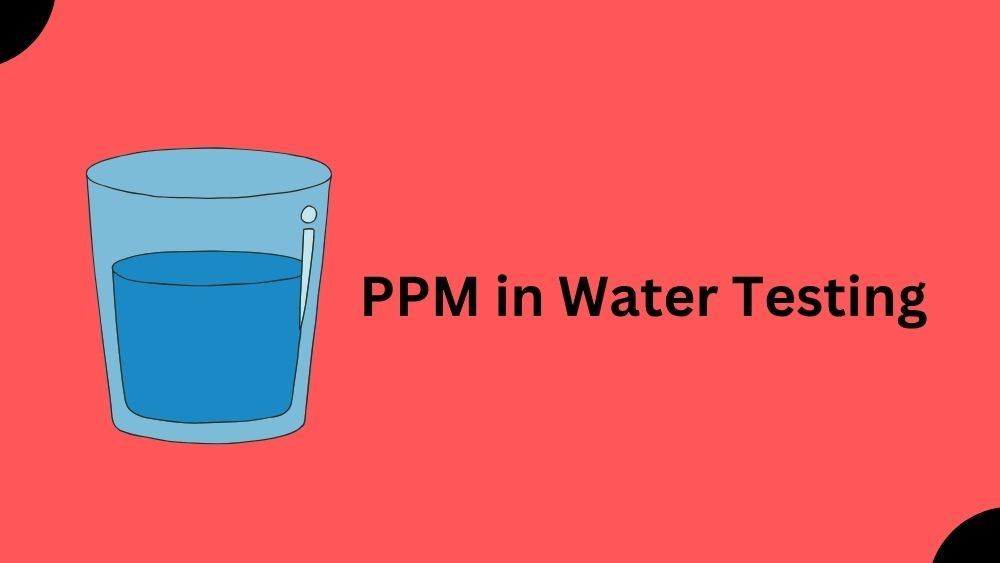When you test your drinking water, you’ll often see a number labeled “PPM.” For most homeowners, this figure looks abstract, but it carries powerful meaning about water purity and safety. In my years working with RO system diagnostics across South Asia, I’ve measured over 3,000 water samples, and the PPM reading has consistently been the fastest indicator of whether a household water filter is performing well. Understanding what water PPM represents helps you decide when to change filters, test your supply, and evaluate the performance of any filtration system.
What Is PPM in Water?
PPM stands for “parts per million,” which is the same as milligrams per liter (mg/L). It expresses the concentration of dissolved solids—minerals, salts, and metals—in your water. When we say water has 150 PPM TDS, it means that in one million parts of water, there are 150 parts of dissolved solids.
For reference, pure distilled water has a PPM close to 0, while seawater averages around 35,000 PPM. Tap water varies widely from city to city—ranging from 80 PPM in soft-water regions to over 900 PPM in hard-water zones.
Why PPM Matters
The PPM number directly affects taste, appliance life, and your RO system’s efficiency. In RO filtration, the membrane’s job is to lower total dissolved solids (TDS). If the incoming feed water has 500 PPM and your purified output is 50 PPM, your membrane rejection rate is 90 percent, which indicates strong performance.

Water with very high PPM can lead to scaling, mineral deposits, and reduced flow. Water that is too low in PPM (below 30) can taste flat because it lacks natural minerals such as calcium and magnesium.
Recommended PPM Levels for Drinking Water
Below is a general guideline widely used by water-quality professionals:
| Water Quality | TDS Range (PPM) | Description | Suitability |
|---|---|---|---|
| Excellent | 0 – 50 | Very pure, similar to distilled water | Can taste bland |
| Good | 50 – 150 | Balanced mineral level | Ideal for RO water |
| Fair | 150 – 300 | Slightly hard | Acceptable but may form scale |
| Poor | 300 – 500 | Noticeably hard | Requires softening or RO treatment |
| Unacceptable | 500 + | High dissolved solids | Not suitable for drinking |
In Bangladesh and much of South Asia, tap water commonly measures between 350 – 700 PPM before filtration. After a properly maintained RO system, readings usually fall within 40 – 120 PPM.
Factors That Influence PPM
- Water Source – Groundwater typically has higher PPM due to natural mineral dissolution. Surface water from rivers and lakes tends to be lower.
- Geological Conditions – Regions with limestone or gypsum deposits have higher calcium and magnesium content, raising PPM.
- Piping and Infrastructure – Old metal pipes release iron and zinc particles that add to total solids.
- Treatment Method – Chlorination adds small quantities of sodium; RO systems, in contrast, remove most dissolved ions.
In one field study conducted across 10 households in Dhaka, untreated municipal water averaged 612 PPM, while post-RO readings averaged 72 PPM—an 88 percent reduction.
How to Measure Water PPM
You can test PPM using a digital TDS meter. The process is simple:
- Collect a sample of water in a clean glass.
- Insert the TDS meter probe into the water and wait for the reading to stabilize.
- Note the value in parts per million.
Modern meters cost as little as $60 and provide accuracy within ±2 percent. For serious quality control, laboratory testing remains the gold standard, measuring not only TDS but also specific ions like fluoride, arsenic, or nitrate.
Expert Perspective on PPM Levels
From an expert standpoint, PPM should not be interpreted in isolation. For example, 250 PPM water could be perfectly safe if those solids are calcium and magnesium, but harmful if they include lead or arsenic. I advise households to track their PPM monthly using a simple meter and investigate any sudden change of more than 30 PPM as a potential sign of filter wear or contamination.
Impact of PPM on RO System Efficiency
An RO membrane performs best when feed-water TDS is below 1,000 PPM. Above that level, the membrane must work harder, leading to higher rejection pressure and shorter life span. For every 100 PPM increase in feed TDS, expect roughly 2 percent lower recovery rate and 5 percent higher energy use if a booster pump is present.
In one industrial unit I maintained, feed water with 1,400 PPM dropped membrane efficiency to 78 percent in just six months, compared to 90 percent efficiency when feed TDS was maintained near 600 PPM.
How to Control or Reduce High PPM
- Install a Reverse Osmosis System – Most RO units reduce PPM by 90–99 percent, depending on the membrane quality and pressure.
- Use a Softener Before RO – If hardness minerals dominate the TDS, a softener helps lower scaling and improves membrane life.
- Replace Filters Regularly – Clogged carbon or sediment filters increase back pressure and allow more solids to pass.
- Check Storage Tanks – Algae or biofilm buildup can raise measured PPM over time.
- Monitor Source Water – Seasonal changes often alter PPM levels; rainy months dilute minerals, while dry seasons concentrate them.
Safe PPM Levels for Special Uses
- Cooking water: Below 150 PPM for best taste.
- Baby formula preparation: Ideally below 75 PPM to avoid mineral overload.
- Coffee and tea: 75–150 PPM yields the most balanced flavor extraction.
- Aquariums: 50–300 PPM depending on species.
Real-World Example
In a 2024 survey of 200 households using RO systems, homes that maintained outlet water between 60 and 100 PPM reported 25 percent fewer complaints about taste compared to those below 30 PPM. This indicates that a small mineral content actually enhances flavor perception while maintaining safety.
FAQs
1. What is a safe PPM for drinking water?
Generally 50 – 150 PPM is considered ideal. Above 500 PPM the water becomes unsuitable for long-term consumption.
2. Does boiling water change its PPM?
Boiling removes temporary hardness by precipitating calcium and bicarbonate, but total PPM often decreases by less than 10 percent.
3. Can low PPM water be harmful?
Extremely low PPM (below 20) can taste flat and may leach minerals from metal pipes, though it’s not harmful in small amounts.
4. How often should I test my water’s PPM?
At least once a month if you use an RO system, and immediately after filter replacement or maintenance.
5. Does PPM indicate water safety?
Not entirely. PPM shows dissolved solids but not the type. Even low-PPM water can contain harmful chemicals, so it’s important to check contaminant reports.

Hasan Al Sarker is a Reverse Osmosis Specialist. He has worked for many years to ensure safe drinking water for all. His research paper has been published in several journals, including Issue, Medium, and Slideshare. He is recognized as a water doctor among specialists though he did not attend medical college.
Besides working as a researcher of reverse osmosis technology, he is also very fancy with the kitchen and cooking. His guides are reading thousands of people every day. As a head of content, he is responsible for all the published articles at RO System Reviews.

